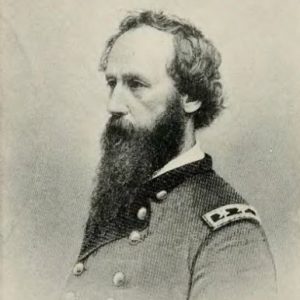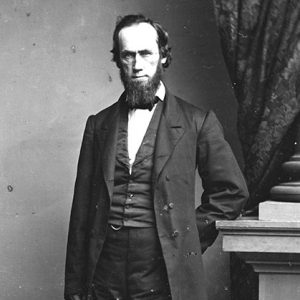calsfoundation@cals.org
William Vandever (1817–1893)
Representing Iowa in the U.S. House of Representatives, William Vandever led Union troops at three major Civil War battles in Arkansas. His war service concluded with a promotion to brevet major general and service after the war included a second stint in the House representing California and a term as United States Indian Inspector.
Born on March 31, 1817, in Baltimore, Maryland, Vandever was the son of William Vandever and Margaret Denike Vandever. Attending schools in Baltimore and Philadelphia, Vandever moved to Rock Island, Illinois, in 1839. Trained as a surveyor, he worked in Illinois, Iowa, and Wisconsin, while also operating the Rock Island Advertiser newspaper. He married Jane Williams in 1847, and the couple moved to Dubuque, Iowa, in 1851 and eventually had four children. Studying law while working for the surveyor general, Vandever joined the bar in 1852.
Vandever helped organize the Republican Party in Iowa in 1856 and was elected to represent the Second Congressional District in 1858. Reelected in 1860, he participated in the 1861 Peace Conference in an effort to avoid war. Returning to Iowa without resigning his seat, Vandever received command of the Ninth Iowa Infantry with the rank of colonel. The House Committee on Elections ruled that Vandever was no longer entitled to the seat but did not remove him from office. The regiment served in St. Louis, Missouri, before joining the Army of the Southwest under the command of Brigadier General Samuel Ryan Curtis, who formerly served as the other Iowa representative in Congress alongside Vandever.
Vandever participated in the Battle of Pea Ridge as a brigade commander, with his unit suffering heavy casualties. The brigade consisted of his original regiment, a regiment of Missouri infantry, and a battery of Iowa light artillery. Moving with the Federal army across southern Missouri and northern Arkansas, Vandever helped capture Helena (Phillips County) in July 1862. A camp in the town was later named for Vandever. While stationed at Helena, Vandever commanded troops defending the town, including at the Skirmish at Helena on September 20, 1862, and at the Skirmishes at Marianna and LaGrange. Promoted to brigadier general on November 29, 1862, Vandever was without a command for a short period and participated in the capture of Fort Hindman in January 1863. He assisted Brigadier General John Thayer and commanded his former regiment in the assault.
After fighting at Arkansas Post, Vandever took command of the Second Division of the Army of the Frontier in southeastern Missouri on April 9, 1863. Leading the division against Confederate forces under the command of Major General John S. Marmaduke, Vandever pushed the enemy southward through Missouri. Escaping into Arkansas, the Confederates made their escape across the St. Francis River at Chalk Bluff. Vandever’s command was unable to stop the enemy and could not cross the stream in the face of Confederate fire.
On June 11, 1863, Vandever took command of a brigade in Brigadier General Francis Herron’s division at Vicksburg, Mississippi. After capturing Vicksburg, the brigade participated in a movement against Yazoo City. Vandever was reported to be aboard the USS Baron DeKalb when it sank after detonating a mine. That fall, Vandever led his brigade down the Mississippi River and joined the Department of the Gulf. The unit participated in the November 1863 capture of Brownsville, Texas. On November 11, Vandever was relieved of his command and transferred to the Department of the Tennessee. On January 25, 1864, Vandever received orders to return to Iowa on recruiting duty. Returning to active service that summer, Vandever commanded a brigade during the Atlanta Campaign and received some criticism for not providing foodstuffs to Union hospitals in Rome, Georgia, where he commanded Federal forces. Serving on the court-martial board for Brigadier General Thomas W. Sweeny, Vandever concluded the war commanding a brigade in the Union Army of Georgia.
After receiving a brevet promotion to major general on June 7, 1865, Vandever left the army that September and returned to Iowa. Vandever resumed his law practice and considered running for his former House seat but instead accepted a position as United States Indian Inspector, serving from 1873 to 1878. During his service, he became a vocal critic of federal Indian policy, leading to his reprimand and non-reappointment. Mining for several years in the American Southwest was followed by a move to California in 1884. Vandever returned to the U.S. House of Representatives in 1887, representing the Sixth District of California. He served one additional term before retiring.
Vandever died on July 23, 1893, and is buried in Ventura, California, alongside his wife, who died in 1908.
For additional information:
Anderson, Douglas Firth. “‘More Conscience Than Force’: U.S. Indian Inspector William Vandever, Grant’s Peace Policy, and Protestant Whiteness.” Journal of the Gilded Age and Progressive Era 9, no. 2 (2010): 167–196.
Bearss, Edwin C. “The Battle of Pea Ridge.” Arkansas Historical Quarterly 20 (Spring 1961): 74–94.
———. “The First Day at Pea Ridge, March 7, 1862.” Arkansas Historical Quarterly 17 (Summer 1958): 132–154.
Deaderick, Michael R. “A Survey of Civil War Combat along Crowley’s Ridge.” Arkansas Historical Quarterly 80 (Autumn 2021): 353–374.
“General Vandever.” Annals of Iowa 5 (April 1867): 854–857.
Papers of William Vandever. Charles C. Myers Library. University of Dubuque, Dubuque, Iowa.
Warner, Ezra. Generals in Blue: Lives of Union Commanders. Baton Rouge: Louisiana State University Press, 2006.
David Sesser
Southeastern Louisiana University



 William Vandever
William Vandever  William Vandever
William Vandever 



Comments
No comments on this entry yet.